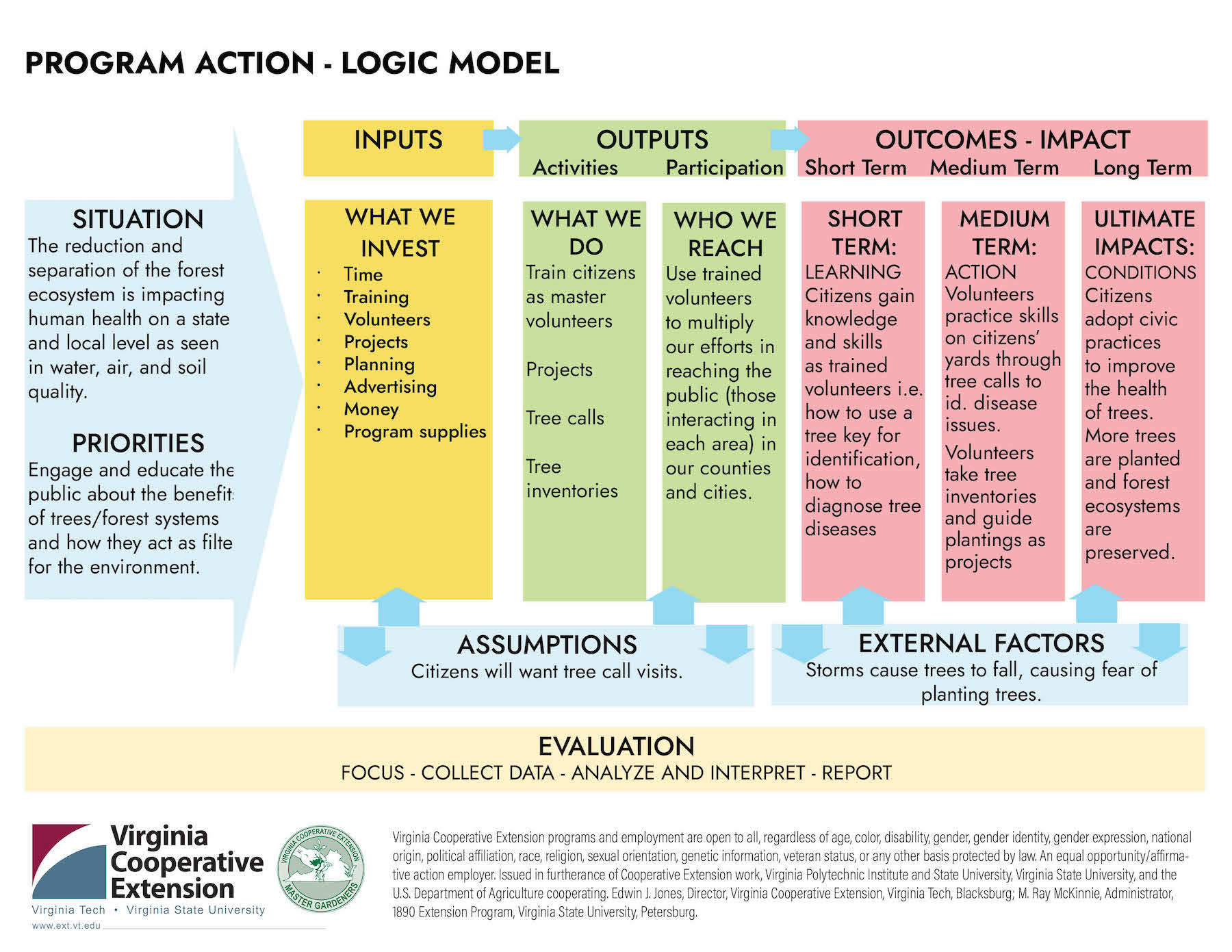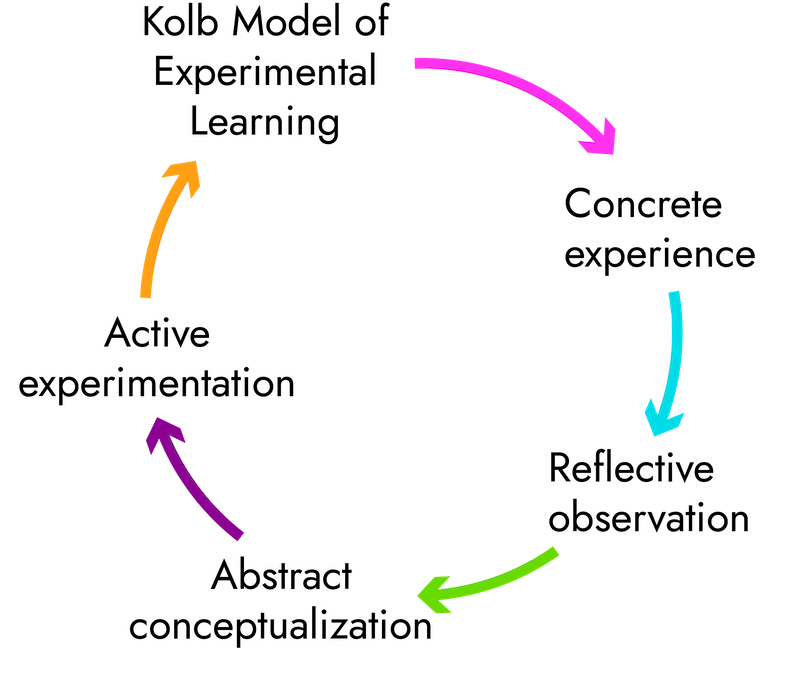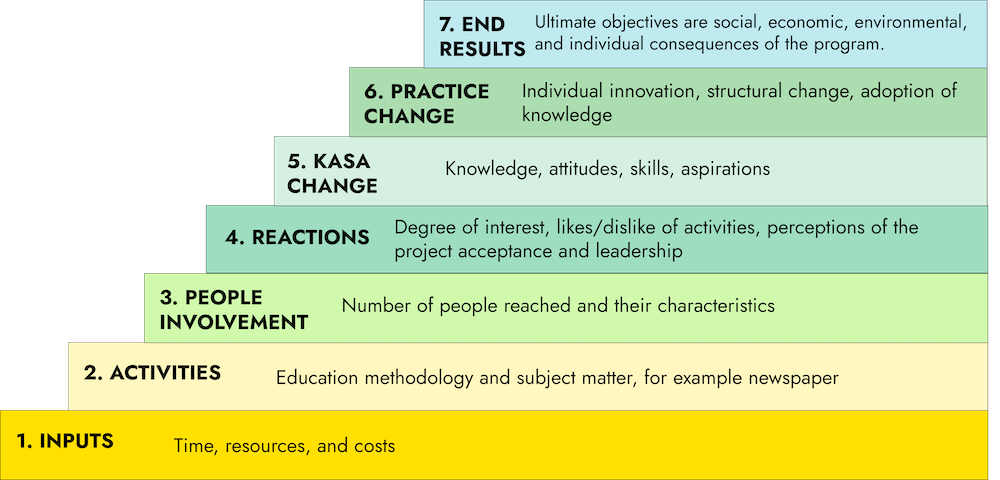Chapter 2: The Learning Experience
“It is impossible to map out a route to your destination if you don’t know where you’re starting from.”- Suze Orman
Chapter Contents:
Introduction
In EMG we use program planning to develop educational opportunities for the public. Why do we do program planning? We use program planning as a tool to create a learning experience for the public, which are based on identified needs. Virginia Cooperative Extension is based on public needs identification and iterative educational programing to focus on answering those needs. The entire Master Gardener Tree Steward Certification process is part of a larger program which focuses on the value of the forest ecosystem. This ecosystem enhances our air, water, and soil quality inside the dome of our atmosphere through multiple scientific processes. In this chapter we will focus on the process of program planning for new Tree Stewards to use as they develop projects that meet the needs of the community and their own education as Tree Stewards.
Learning Objectives
- Understand Virginia Cooperative Extension Learning Experience
- Identify the steps in Program Planning
- Understand a Logic Model
- Understand the differences between lectures, demonstrations, workshops and projects
REVIEW:
- VCE Master Gardener Handbook (2015 Ed): Chapter 1, Welcome to VCE Master Gardening
Educating the Public through a Learning Experience
A learning experience emerges from a journey through the combined acts of perception, action, emotion, understanding, and motivation. This encased in one’s sense of the world, brings about a new paradigm or lens for processing experiences. How do you create perceived value and inspiration in a package to motivate the public to; study, protect, enhance and extend our local forest systems? That is the guiding question we are striving to answer as tree stewards and should also be the basis for our projects as we do program planning.
What is the purpose of a project? A project is one step in program planning that allows volunteers to experience the knowledge and new processing lens that they have gained from their course work in a real world application. The most important step in creating a lasting impact is giving the knowledge user the ability to engage their skill within their local atmosphere so to speak. If the skill is not repeatable, adjustable or relevant enough the information is put on a shelf so to speak in our sub-consensus and enthusiasm for the knowledge wanes. Giving validity to the experience through a project is just one part of program planning that makes up the learning experience.
Program Planning Steps
- Assess the needs of the community and set priorities
- Program development (map of inputs, outputs, outcomes)
- Developing the learning experience (presentation, project, activities)
- Develop promotion (marketing materials) of the program
- Delivery of the presentation or implementation of the project
- Evaluation (How did it go?)
- Communicating results (tell the program’s story)
There are 7 major steps in program planning for a learning experience. The first step is to assess the needs of the community and set priorities. In this instance community means more than just the local citizens, it means all people that interact in an area. This includes groups like churches, Boy and Girl Scouts, schools, societies, clubs, places of work, local stores, local government as well as the actual inhabitants. How do we connect to community needs? How do we connect the value of the forest ecosystem to citizen’s daily lives? What needs are out there that we might help address with education? To answer these questions we need to listen, observe, and examine what is going on around us locally. Examples of issues could be recurring flooding, poor air quality, lack of healthy foods to eat, obesity, lack of connection to nature or agriculture, or lack of value for the ecosystems in general. Every need won’t be addressable, some needs will be greater than others, and some needs will fit better as educational opportunities that we can focus on. Some criteria that can help us prioritize these identified needs are; the importance of the issue, the number of people affected, how it fits the VCE mission, how important is it to local officials, what Extension’s ability to respond is, and who else is working on it.
This is a fairly rural county just north of the Hampton Roads urban concentration. It has a lot of forest land, including along the Chesapeake Bay and York River, but not very much public park land. A few years ago, local benefactors gave the county 100 acres for a park in the middle of the county. So, here was both a need and an opportunity. The local EMG TS saw an opening for incorporating trees and tree education in the planning process from the beginning.
Step 1: Assess Need. Partly done already, just because they lived there and were already involved with county issues. EMG TS then got themselves included with community actors and county government officials in the ad hoc committee which assembled to decide what needs the park should address: for example, a soccer field. Some of the land was open with poor drainage, while the rest was forest and forested swamp. It was clear that any plan had to take into account what was already there.
Once the assessment is done, and the major educational priority themes are fleshed out, the second step is to create a map (program development). The first task in the planning step is to document objectives, necessary inputs, expected outputs, assumptions, external factors, short & medium term outcomes and long term impacts. Several tools have been developed to help in this process. For objective setting, part of the map, there are two major tools commonly used, the S.M.A.R.T. and A.B.C.D. Models. The first acronym stands for learning objectives that meet the following criteria; Specific, Measurable, Attainable, Results-Focused, and Time-Focused. A third tool that will help you with the bigger picture is the logic model which basically helps you create a visual road map for your programing. All of these tools can be easily researched on-line, but we will go into more detail about logic models, as it is a foundation to Extension Programming across the Country.
Logic models help us develop logical connections between what we need, who we need, what we do, what we accomplish and how it can be tweaked to improve impacts based on what we have observed. This is set up in the form of; situation statement, inputs, outputs, outcomes, impacts, assumptions, and external factors. It answers the question “How do you know if you have arrived, if you don’t know where you are going?” A logic model helps link activities to results, serves as a basis for communication with others, guides program planning and evaluation, makes gaps in logic visible, makes explicit theories of change, and improves decision-making. The situation is defined as the current condition, issue or opportunity calling for programming. An input stands for resources we invest to bring about change. Outputs are what we generate such as activities and products. Outcomes are short and medium term and speak to what is different as a result of our efforts. Impacts are the long term version of outputs that affects conditions such as social norms, economics or the environment. Assumptions are beliefs and expectations that inform our programming choices. External Factors are influences that are outside of our control.
Logic models were created based on Bennett’s Hierarchy (a well-known model for evaluating program outcomes). It is measured in 4 stages known as K.A.S.A., with the purpose of initiating change. K.A.S.A. stands for Knowledge, Attitudes, Skills, and Aspirations. The theory is that through gained knowledge, people’s belief in a practice can be developed and attached to a skill that will ultimately help them create improvement. The logic model helps us ultimately take a situation statement and outline your objectives (outputs), programs/projects (inputs) and create measurable knowledge, attitude, skills (outcomes) and aspirations (impacts). Logic models also bring planning aspects together in a map that helps us identify areas for evaluation and iteration. Here is an example of what a MG Tree Steward Program Logic model might look like.

Now that we have touched on the first two steps of project design, let’s move to the third step, developing the learning experience. What is a learning experience again? A learning experience is a systematic set of learning activities taking information, curiosity and challenges or “games”, to create an “Aha!” moment based on the learning objectives. It uses the power of discovery to engage the learner so that they understand the basis of the lesson and how it can fit into their perception of the world. By creating a self-actualized moment the person becomes more self-directed and resourceful with the new idea or understanding in applying it to their life. As part of the learning experience you will need to decide how to develop the format, create a schedule, who will deliver the lesson, the location and develop the teaching materials.
The fourth step is to develop the promotion of the program. Marketing is key to programs so that you can try to reach your intended audience with the information. You will need to decide what the expenses will be, how to obtain resources or how to solicit sponsors to provide the resources and then create the marketing tools and schedule. This is a crucial action and should be thoughtfully approached because without participants your planning efforts will not be utilized and your time will be wasted.
The fifth step is delivery of the presentation. As part of the delivery of the presentation, it is beneficial to look at delivery techniques such as lectures, discussion (audience speaks more than presenter), case studies or problem oriented approaches. In the problem oriented approach the learner is given a mental picture of a situation and then a problem is introduced that they must gather information to form a solution. This challenge engages learners to keep them interested through creating a need in their local situation so they can connect and visualize the experience. Practice of the solutions as part of the lesson leads to better application in a learner’s daily life and helps them transfer their new skills to their situation. It is helpful to remember that the quality of a few experiences outweighs the quantity of information gathered. Practicing your presentation on a person outside of your field helps point out pitfalls that may cause confusion or lack of transfer with the information.
Woodville, Step 5: Project Delivery. At this point in the park development, a large new pond had been laid out to manage the drainage, with a second one planned. The EMG TS organized volunteer plantings of trees around the ponds, as well as riparian buffers with grasses and shrubs to handle the runoff from the sports fields and parking lots. The EMGs and other local groups set up Demonstration Gardens, extending the educational impact.
Here are some tips for engaging adult learners: start by explaining the purpose and objectives, stay task oriented in your instruction, relate the content to the learners lives, focus on the quality of several experiences rather than quantity of information, and keep the lesson in progression from concrete (learners physical experience targeting the senses to create a memorable example) to the abstract (how does this apply to the world and how can it be used?). The model below is an additional way to describe this.

What are the differences between lectures, demonstrations, workshops and projects? Lectures include short-term intensive learning, demonstrations include active involvement and projects include active experimentation. Workshops incorporate more concepts to include intensive learning, small group interaction, active involvement and application of the new learning encompassing the learner objectives. Workshops allow the learners to have time to interact with other participants to share their situations and help each other form strategies for dealing with the presented challenge. This time increases the impact of the learning experience through active involvement. A final thought for delivery of the program comes from correlation between presenter behavior and learner achievement. Achievement is measurably higher when the presenter has clarity, variability in strategies, discussion, and assessment, enthusiasm, task/achievement oriented behaviors and when the learners are given a clear correlation between the learned information and achievement (no wasted time).
The sixth step in program planning is evaluation and is a very important part of the iterative process. Without feedback a program would grow from only one view rather than the sum of all views. We evaluate programs to help us make better decisions about the future of the program itself. Should we keep it, improve it, or remove it? We should always be asking those questions in extension, to make sure we are up-to-date in assessing our community needs, efficiency, and effectiveness. Ultimately, extension evaluation results are reformed into outcomes and impacts showing public accountability to stake holders including funders, sponsors, and government.
A key aspect of evaluation is identifying an indicator (a marker) that can be observed to show change. Good indicators relate to the objectives of the program, are understandable, are measurable, relevant, provide a representative picture, and can be updated. Bennett’s Hierarchy of Evidence (model below) provides a way of understanding the relationships between program objectives and outcomes at different levels of the program and suggests the information that is appropriate to measure to satisfy achievement of the objectives.
Evaluation can be done in multiple stages of planning. Assessing community needs for program design is one form of evaluation. For an initial program you may want to start with a baseline study to capture what the current level of knowledge, attitudes, skills, and aspirations of the audience are. It is also a good time to capture what priority areas exist for intervention and what resources are available for problem solving. For an ongoing program it is best to use a formative evaluation in which questions are asked to help improve, modify and manage the program. What did you learn? Will you be able to use the skill you learned? At the end of a program a summative evaluation is appropriate to ask what were the outcomes, who participated and how and what were the cost associated with the program? Once the program is over questions are asked as a follow-up study like; what were the impacts, what was most useful to participants, and what were the long-term effects? The culmination of this information helps determine the value of the program and can be balanced against the costs to make judgement decision for its existence.

The seventh and last step in planning is to communicate results. An effective way to do this is to paint a short story as to how the Extension program makes a difference in the lives of the people it serves. Tell why (rationale) and how the program was implemented (objectives and methodology), the measurable results or how program success was achieved (outcomes and impact), and define the public value of the program (future potential). In summary it is very important to have a road map for a program to insure its success and it is key to look, plan and evaluate as part of this road map.
Review Questions
- What is the difference between an Output and an Outcome?
- What does K.A.S.A stand for?
- What is the importance of using a logic model?

